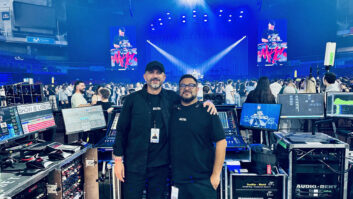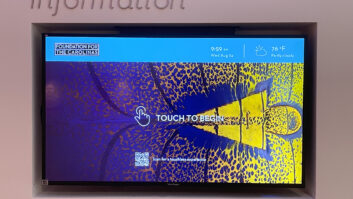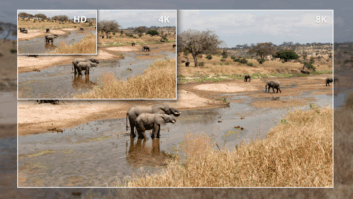Sony Metreon
Feb 1, 2001 12:00 PM,
By Judith Rubin
In each [attraction], Sony took the work of a livingartist/author expressed in 2-D illustration and text and evolved itinto a 3-D, enter-the-book experience.
SAN FRANCISCO IS A FASCINATING STUDY IN OPPOSITES. As one of theoldest West-Coast towns, it still has some architecture that’s wellover a century old, like St. Patrick’s Church. Across the streetfrom this church is a technological monument called theMetreon.
Metreon is Sony’s trademarked name for its own special brand ofurban entertainment center. Created by Sony Development, a divisionof Sony Corporation of America, the flagship venue is housed in a4-story complex in San Francisco’s thriving South of MarketDistrict.
Metreon features three unique, permanent themed attractionsdeveloped by Sony through the licensing of unique intellectualproperties. In each case, Sony took the work of a livingartist/author expressed in 2-D illustration and text and evolved itinto a 3-D, enter-the-book experience.
Where the Wild Things Are/In The Night Kitchen is an interactivewalk-through attraction for children, a restaurant and a retailstore, all based on the works of children’s book writer/illustratorMaurice Sendak. Wild Things takes a classic theme-park approach inallowing you to become a character in the story; you meet andmanipulate Sendak’s characters and creatures in the Wild Thingsfunhouse. The walk-through employs many standard theatrical andmagic devices.
The Airtight Garage is a sophisticated multi-user game room forolder children and adults based on the work of graphic novelistMoebius (Jean Giraud). Airtight Garage fleshes out theother-worldly flavor and the futuristic fantasy environments ofMoebius’ work. You don’t so much walk into the world of his novelsas into a world devoted to and inspired by them. The attractionfeatures three virtual-reality games created through thecollaboration between Sony and Moebius.
The Way Things Work — In Mammoth 3-D is a walk-throughenvironment culminating in a 3-D video theater experience, plus aretail store, based on the work of author/illustrator DavidMacaulay. Named after Macaulay’s best-selling book, The Way ThingsWork preserves the feeling of ink on paper and produces a sense oftraveling through a giant version of the book with its layman’sexplanations and playful illustrations of machinery.
Metreon combines these attractions with restaurants, retailstores and a 15-screen movie theater complex that includes the SonyImax 3-D theater, the very first large-format theater inmetropolitan San Francisco. Everything has been carefullycustomized for the Bay Area. The restaurant area, A Taste of SanFrancisco, showcases the area’s unique chefs and eateries. Retailincludes Sony Style, PlayStation®, theDiscovery Channel Store, andmicrosoft®SF. Sony Development is themaster tenant of the building, designed by local architects SimonMartin-Vegue Winkelstein Morris, with Gary Edward Handel &Associates of New York. Developers were Millennium Partners, NewYork, and WDG Ventures, San Francisco.
Metreon promotes the involvement of local, women-owned andminority-owned businesses. This effort began at the design andconstruction phase, and San Francisco area companies dominate thevendor list. The Sony team roster likewise contains a remarkablenumber of Disney veterans, including John K. MacLeod, senior vicepresident of development and operations for Sony Development;Trevor Bryant, senior vice president of the creative division, SonyDevelopment; Kari Novatney, vice president and general manager ofMetreon; Scott Sinclair, executive creative director of SonyDevelopment; and David Spencer, senior vice president of theEntertainment Technology Group, Sony Development. (Since thecompletion of Metreon, Sony Development has mutated into HyperEntertainment, headed by Mike Sweeney.)
INSTALLATION CHALLENGES
Everyone concerned with the show design and installation raninto challenges. There were challenges in combining the show designand architecture, working within a compressed constructionschedule, adapting to the pre-existing building design, andincorporating the physical aspects of the building and itsmaintenance. Natural light flooding through the mostly glassnortheast face of the building limited lighting design. Fixtureswould be permanent and would be serviced by a building maintenancecrew. Seismic and structural requirements were stiff, partly due tolocation (earthquake country) and partly because the complex wasconstructed on top of an existing building (the nearby MarriottHotel’s underground ballroom).
HVAC was the worst obstacle. Huge air ducts would appear inplaces other than those specified on the plans, forcing showdesigners to compromise. The HVAC components also greatly reducedceiling heights in some places. Designers compensated by leavingthe spaces without ceilings and painting out the elements overhead;specifying compact, versatile fixtures; working closely withfabricators to keep weight and load-bearing at a minimum; andgenerally adjusting and readjusting their work.
“Show design with a lot of theming was happening on top ofstandard building construction,” said York Kennedy ofGallegos Lighting, which did lighting design for Wild Things andthe interiors of all the movie theaters. “There was the HVAC,which kept moving around. There was lots of hanging foliage. Therewas rock work and character work, including swinging characters inthe air. Our lighting installation and everything else had to go inbefore the swinging things went in. While the crew was working onthose, they’d knock our stuff back up into the ceiling. Then we’dhave to reposition and refocus everything.”
“HVAC is always a problem,” concurs DawnHollingsworth of Moody Ravitz Hollingsworth, which providedlighting design and service for the Way Things Work attraction.“It never gets coordinated properly. What engineers put ondrawings is never what gets built in the space. But everyone needsto have a fair chance to have the ceiling space. The reason you’reselling tickets — the reason you’re there in the first place— is actually being impacted by these changes. But thesethings do happen on a construction site. The most amazing thing isthat they get built at all.”
“You have to enjoy thinking on your feet,” saysScott Sinclair, the project’s concept designer and a member of theSony team that decided what to put into the building. “Youhave to be able to deal with someone saying ‘I hate to tellyou this, but there’s a piece of ductwork going through yoursky.’” Sinclair found the process very different fromwhat he’d been used to in his days as a Disney engineer, where“the building would be shaped around the show.” He alsofound it educational. “I learned a lot about HVAC andbuilding codes. The architectural firms had to do some learning,too.”
Sinclair continues, “The San Francisco code restrictionsare based on fear of earthquakes. The resulting building is a hugetruss with heavy diagonal bracing and really large columns. Thecity may fall down someday, but Metreon will still be standing! Irespect architects a lot more now than I used to. The codes are sorestrictive that if they can make a building that looks good, it’squite an achievement.”
Each attraction team relied on one or more peacemakers tocoordinate tasks and keep people communicating and findingsolutions. York Kennedy credits Gus Sanchez of Cupertino Electric,Paul Strangmeyer, the floor foreman and Dave Clare, vice presidentof Sony Entertainment group production, for keeping things fromgetting too wild in Wild Things. For playing valuable coordinationroles on The Way Things work, Delphi cited Hathaway DinwiddieConstruction, the tenant improvement construction managers, and MRHpraised Chris Collins of Yeager Design. Audio providers IntellisysGroup and David Carroll Associates both mentioned Sony’s MikeHaimson (see sidebar).
TO THE MAX
The Wild Things show starts in the bedroom of the maincharacter, Max, where through a combination of scrim work andPepper’s Ghost effects, using a 50% mirror and a Sony VPL-1800projector, the scene magically changes into a moody child’s nightforest. Guests progress through a Sendakian gallery of art, visualeffects and interactive elements. Images mysteriously arise from agoblin’s smoking cauldron, thrown onto the smoke (a fog effectsupplied by IST’s Ultrasonic Fog) by a sensor-activated SonyVPL-900 video projector triggered when a person leans or reachesover the pot. Footprints on the carpet talk back when stepped on.In the echo chamber, your voice is hilariously distorted by Sonymicrophone processors. More Pepper’s Ghost effects and theatricalillusions provide shifting pictures along the corridors.
Proceeding gradually upward, you emerge onto a balconyoverlooking the lower level. The balcony is a play area withfake-out viewing devices that show you your own rear end, speakingtubes that let you communicate with the folks on the lower leveland wisecracking little goblins that poke their heads out of holesand taunt you to push them back down. There are also devices thatlet upstairs guests manipulate characters to interact withunsuspecting guests below, who don’t realize others enjoying theattraction are manually creating the effects on the spot. Thevarious mechanisms were produced by Sony. From the balcony area,guests descend by slide or ramp to the jungle playground. Here,accompanied by vibrant klezmer music (Sendak himself specified allthe music in the attraction) and with the cityscape visible throughthe huge windows, you can operate parts of the giant Wild Thingcharacter on the wall by pulling ropes and stepping on spots on therug. There are also blocks to play with, made of dense foam paintedto resemble wood; caverns to duck into, made of fiberglass finishedas rock; and Wild Things flora and fauna to grab onto, sculpted ofsteel and fiberglass for endurance.
This 15,000-square-foot attraction is complemented by a retailspace of equal size. The space is themed as an old theater, with astage for readings and performances, and a collection of Sendakcharacters as flats, dolls and sculptures, some suspended from theceiling and some leaning over catwalk railings. The items for saleinclude tools for fostering children’s creativity, such ashigh-quality art supplies, mixes for baking crunchy eyeball cookiesand a fine selection of classic children’s literature handpicked bySendak. In addition to his own titles are works by James Thurber,Beatrix Potter, Laura Ingalls Wilder and others. There are alsolicensed merchandise and high-ticket, one-of-a-kind items byartisans who work with Sendak.
SOUND SYSTEM
Paul Chavez of Intellisys Group was audio engineer and projectmanager for Wild Things, working with Sony’s sound designer AaronRichards. Others on the audio team were Intellisys’ James Renney asprogrammer/show control designer and John Neff, fieldsupervisor/chief installer. All the audio processing is done via aPeavey Media Matrix system. The Media Matrix is Windows NT-basedand has an audio-to-Ethernet interface that involves a Media Matrix980 mainframe CPU to hold CobraNet digital sound processor cards,which plug into 100 base-T computer hubs that plug into standardaudio interfaces. Peavey-supplied software enables custom setup ofa user-friendly graphical interface for remote monitor andcontrol.
Audio effects emitting from props play on PC card digitalplayback units from Maris. Background music runs on Sony RS-232 CDplayers. Speakers used in the attraction include EAW JF60s and JBLControl 25s for props and Renkus-Heinz TRC 61s for backgroundmusic, plus some JBL Control 24 CT ceiling speakers and someRenkus-Heinz TRC-81s. Amplifiers are mostly Crown ComTech.Everything feeds into an Anitech show control system that includesa custom hands-off audio panel. The show control system aloneincludes some 2,000 wire pulls, 90 loudspeakers, 88 inputs and 80outputs.
To streamline the audio work and simplify installation andmaintenance, Sony’s Mike Haimson brought all the audio engineerstogether for weekly meetings to exchange ideas and establish someoverall audio standards. The Anitech show control systems and MediaMatrix processors and operator control panels, for instance, areused building-wide. “It was an economy of brainpower,”comments Paul Chavez. “If the audio had been developedseparately from space to space, it could have been a disaster. Mikemade sure that didn’t happen. Every team didn’t have to developevery single thing, and the operator benefited from thestandardization.”
HOW DOES IT WORK?
The Way Things Work is a three-part experience that begins withMelvin the Talking Robot working the crowd. Next is a galleryfilled with humming mechanical exhibits a la Rube Goldberg —with pulleys, gears and rope, plus a booth where you see Melvin’shuman operator. A video pre-show is broadcast on a 50-inch diagonalfront projection screen by Stewart Filmscreen with a Sony VPL-1800projector, and on two Sony PGM-200 R1U monitors. There are hundredsof these monitors, able to display both computer and video input,throughout the Metreon complex.
The pre-show sets you up for the main show, which is a 9-minute,3-screen, “live” session in the 199-seat theaterequipped with eight Sony VPL-1800s. One is used for each of theouter screens and two for the 3-D center screen. The original planwas to have double the number of projectors working on each screenfor more brightness, but this was found to be unnecessary. The showincludes in-theater effects such as seat rumbles created by Auratransducers and a water spray provided by Mee Fog nozzles.Animation sequences were by Bob Kurtz & Friends; Sony’s ValerieJohnson produced the video, which is stored on Sierra Design Labuncompressed digital video disk playback units that process 270megabits per second and feed the data stream to the projectors.
Audio playback is also digital, using a Tascam MMP 16 digitaldubber specified by David Carroll & Associates, which providedproject management and system integration for audio, video and showcontrol throughout the attraction. The Way Things Work uses speakerequipment including C-6 three-way P.A. front cabinet speakers fromAudioTek, Control 25Ts, Control SB subwoofers, and SP 212s and SP222s from JBL, as well as Renkus-Heinz TRC 61s and TRC 81s.Amplifiers are Crown CT and Macro series. In this attraction, aswell as many satellite equipment rooms in the complex, engineerssaved precious space by using front-mounted, swing out equipmentracks from Signal Transport. The pre-show audio playback is donewith a pair of V-1M digital disk recorders from Doremi Labs.
AIRTIGHT OPERATION
An interesting effect is seen at the front of the AirtightGarage. As you enter the 15,000-square-foot attraction created incollaboration with Moebius and themed as a slightly moth-eaten gameroom, watering hole and intergalactic space portal, you encounter asculpture of Malvina, the mythic female who colors Moebius’ books,holding a trapezoidal screen that flashes video images at theentrance. The picture is rear-projected through a piece of privacyglass using a Sony VPL 900 projector. The featured sports areQuaternia, a video console game; HyperBowl, a virtual bowlingalley; and Badlands, an outer-space treasure hunt. Quaternia iswhat’s playing on the bulk of the 105 stand-up game stations, eachequipped with a Sony PGM 200 R1U monitor. Putting you in charge ofa bowling-ball-sized trackball custom engineered by SonyDevelopment Inc., Hyperbowl lets you knock down virtual pins on thestreets of San Francisco. Sony VPL 900 video units project ontotall vertical screens that allow spectators an easy view. Thescreens were painted right onto the walls with a special substancefrom Stewart Filmscreen. Badlands is a competitive game played inindividual motion simulator pods, themed as space travel vehicleshoused in a “garage.” Jesler supplied the 28 ridevehicles. Each is equipped with a Sony VPL-600 rear projector thatprovides real-time CGI views of the game environment.
These multi-user games provide CGI 3-D-rendered environmentsusing Intel Pentium 3500 motherboards, RIVA TNT2 3-D graphicsprocessors from NVIDIA, Diamond Viper V770 AGP video cards andDiamond Monster sound cards. The games are linked through anEthernet network. Game controls were developed and manufactured bySony.
Lighting design for The Airtight Garage was done by Lightswitch,relying heavily on the Lightolier 8201 track fixture. Lightswitchprincipal Abigail Rosen Holmes also specified a few pendantfixtures from Abo Light and Limburg Glass. There is no naturallight in this space; illumination is low and dramatic in keepingwith a game-room atmosphere. The audio vendor was BakerEntertainment Integrators.
“This was the most exciting project I’ve ever done,”says Douglas Knab, project manager with Sunbelt Scenic Studios, whoworked on Airtight Garage. As a longtime Moebius fan, Knab said,“For me, it was the culmination of a lifetime of effort andartwork. It fit with the way I draw and think and work; and I triedto make it better than they ever expected it could be.”
Judith Rubin is contributing editor of Entertainment Design. Youcan e-mail her at shmata@idiom.com.
FOR MORE INFORMATION
Abo Light
www.abolight.com
Circle (121) on Reader Service Card
Allen Bradley
www.ab.com
Circle (122) on Reader Service Card
Anitech Systems
www.anitech-systems.com
Circle (123) on Reader Service Card
Bose
www.bose.com
Circle (124) on Reader Service Card
Crown International
www.crownaudio.com
Circle (125) on Reader Service Card
Doremi Labs
www.doremilabs.com
Circle (126) on Reader Service Card
EAW
www.eaw.com
Circle (127) on Reader Service Card
Intel
www.intel.com
Circle (128) on Reader Service Card
IST
www.infoscantech.com
Circle (129) on Reader Service Card
JBL Professional
www.jplpro.com
Circle (130) on Reader Service Card
Jesler
www.jesler.com
Circle (131) on Reader Service Card
Lightolier
www.lightolier.com
Circle (132) on Reader Service Card
Maris Ltd.
www.maris.co.uk
Circle (133) on Reader Service Card
Mee Fog
www.meefog.com
Circle (134) on Reader Service Card
Microsoft
www.microsoft.com
Circle (135) on Reader Service Card
NVIDIA
www.nvidia.com
Circle (136) on Reader Service Card
Peavey
www.peavey.com
Circle (137) on Reader Service Card
Renkus-Heinz
www.rh.com
Circle (138) on Reader Service Card
Sierra Design Lab
www.sdlabs.com/products.html
Circle (139) on Reader Service Card
Signal Transport
www.sigt.com
Circle (140) on Reader Service Card
Sony Electronics
www.sony.com
Circle (141) on Reader Service Card
Stewart Filmscreen
www.stewartfilm.com
Circle (142) on Reader Service Card
Tascam
www.tascam.com
Circle (144) on Reader Service Card








